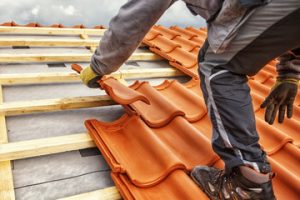A well-maintained roof increases the home’s value and prevents mold growth and structural damage. Roofing maintenance is easy to do and inexpensive if caught early.

Regular inspections of the roof and its components are essential. Keeping gutters clear helps prevent clogs. Re-sealing areas around vents and chimneys reduces leaks. Keep reading the article below to Get a Free Quote Today.
While a few drops of water may seem harmless, they often signal a larger leak that threatens insulation and structural materials. Effective roof leak detection enables timely repairs that protect the structure and interior spaces.
Hesitating to address a leak can exacerbate the problem, resulting in costly water damage. The first step is to contain the water infiltration by placing buckets or pans under the drips, then locating the source of the leak and executing repairs as needed.
Missing or damaged shingles, sagging gutters, and deteriorating flashing can all lead to severe problems. These issues are more than cosmetic concerns, and they should always be handled by a professional to ensure proper installation and prevent the escalation of the problem.
Look for signs of water infiltration in living spaces, such as a musty odor or warping wood and paint. Moisture can penetrate walls, causing mold growth and rot, so it’s important to address these issues promptly.
Begin your inspection in the attic, scanning the ceiling for any dampness or discoloration. Pay particular attention to areas around chimneys, vents, and junctions as these are common sites for leaks. Inspecting these areas is particularly critical after severe weather events as high winds and intense rains can exacerbate existing vulnerabilities in the roofing system.
A garden hose is an effective tool for tracking down leaks by mimicking rainfall to isolate the problematic area. Spray the leaking area in controlled bursts, starting from the lowest part of the roof and working upwards, systematically isolating the area with each pass. Once you’ve isolated the area, check for any water intrusion in living spaces, noting when and where it occurs.
To confirm the source of a leak, it’s helpful to use an electronic moisture sensor that can measure the levels of water in insulation and other building materials. These scanners are affordable and easy to use, making them an essential tool for any homeowner or commercial property manager. However, it’s important to remember that these scanners display relative moisture readings rather than absolute wetness or dryness, so professional help will be necessary to accurately interpret the results.
Inspect the Roof for Damage
A roof inspection is a crucial step in maintaining your home’s structural integrity. A professional inspector will examine the entire roof, not just the visible areas of damage. This can help you identify issues that need to be addressed before they become more serious.
First, the inspector will look at the shingles to check for cracks, splits, missing granules, and other damage. He or she will also examine the condition of the roof valleys, ridges, and any other area of the roof that is particularly prone to leaks or other damage. Inspectors will also look at the gutters, scuppers, and drains to ensure that they are clear of debris and are sealed correctly. If the drains are blocked, water may pool on the roof and cause extensive damage.
Next, the inspector will examine any vents or skylights that are on the roof. Different types of vents and skylights serve different purposes, but they all play an important role in maintaining the overall health of your roofing system. Inspectors will also inspect the neoprene pipe boots, turbine vents, ridge vents, and gable end vents for blockage, damage, or other issues that could affect ventilation or lead to leaks.
Finally, the inspector will check the interior of the attic to look for evidence of leaks, mold growth, or other damage. He or she will also evaluate the condition of rafters, joists, and decking from the inside to make sure they are in good condition. If the inspection reveals signs of leaks or other problems, the inspector will recommend a repair or replacement plan.
Conducting a rooftop inspection requires the use of a ladder and a certain level of skill, but it is essential to keeping your home in good shape. Before you go up to the roof, it’s a good idea to wear non-slip shoes and a harness or safety belt, and have someone with you to assist if necessary. It’s also a good idea to bring along a pair of binoculars or a drone for a closer look, as well as a flashlight and chalk for marking problem areas.
Clean the Gutters
Despite being one of the more unpopular roof maintenance tasks, cleaning your gutters is a crucial component to keeping your roof in good condition. Clogged gutters allow water to seep into the structure of your home, which can cause leaks and mold.
In addition, water that pools in the gutters can create additional weight on the roof and shingle areas, which can also lead to buckling or rot. Finally, the accumulation of water can promote the growth of moss, lichen, and algae, which can further damage your roof.
You should plan on cleaning your gutters twice a year, once in the spring and once in the fall. However, if you live in an area that frequently experiences rainstorms, then you should clean your gutters more often. Additionally, you should check your gutters right before winter to make sure that they are free of any blockages that could cause water damage in the winter.
Cleaning your gutters can be a dirty and time-consuming job. If you are planning on doing it yourself, make sure to wear heavy-duty gloves to protect your hands from sharp objects and eye protection to shield your eyes from the dirt and debris. You should also use a ladder that is tall enough for you to reach the entire gutter and be careful not to place the ladder against any plants or shrubs.
Start by removing the larger debris from the gutters. Once the main part of the clog is removed, flush it out with a hose. If you have a gutter cleaning wand, this can be especially useful since it will provide a more controlled and powerful spray. This will help to remove any lingering debris and make it easier to spot leaks in your gutter.
You should also check the downspouts to make sure they are clear of any blockages as well. A good way to test this is during a rainstorm; you should be able to see water flowing properly from the downspouts, rather than overflowing or pooling around them. If you notice any leaking or blocking, it’s best to call in a professional for a more thorough gutter cleaning.
Inspect the Roof for Moss or Algae
If you live in a humid region, moss and algae can become unsightly and damaging to your roof. While algae stains typically appear as dark streaks, moss grows in thick clumps that may cause shingles to lose their integrity. Both organisms retain moisture, which leads to rot and other problems over time. Inspecting the roof for these unsightly growths is an important step in preventing their spread and ensuring your roof can withstand summer storms.
Moss is a non-vascular plant that typically thrives in damp, shaded areas. It absorbs nutrients and moisture through its leaves and spores, which can be spread by wind or animals. Moss is commonly found on forest floors, rocks, and rooftops. Its shallow roots can penetrate shingle layers and lead to rotting and structural damage over time. Moss can also lift shingles, exposing the underlayment and leading to leaks.
Algae, on the other hand, is a single-celled organism that typically appears as dark streaks or stains. It is often found in the same conditions as moss, and it can be just as damaging to the roof. Algae stains can lift shingles, causing the underlayment to leak, and it can discolor the roof.
While addressing any existing moss or algae is an essential step in roof maintenance, it is even more important to prevent these organisms from growing. Regular inspections, including a spring and fall biannual inspection, are a good way to catch problems before they worsen. Regular gutter cleaning, avoiding debris blockage, and resealing the sealant around vents, chimneys, and skylights can all help reduce the likelihood of moss or algae growth.
To further minimize the chances of unwanted organisms, trim any overhanging trees that could spread bacteria to your roof and regularly inspect the soffits and crawlspace for mold and algae stains. A good preventative measure is to install zinc or copper strips along the eaves of your home, which release natural agents that discourage the growth of algae and moss. The combination of these proactive steps can keep your roof looking beautiful, healthy, and strong for years to come.
